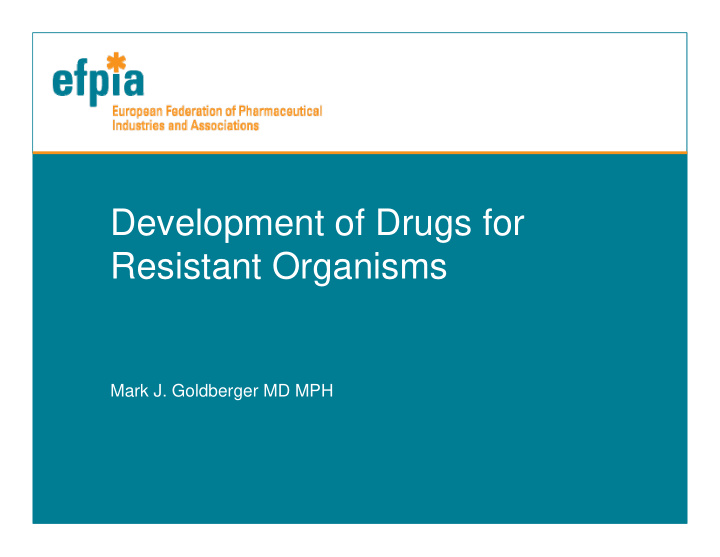



Development of Drugs for Resistant Organisms Mark J. Goldberger MD MPH
Goals for a Program • Expedite the development of products for resistant or rare organisms – A focus on the quality of the program rather than its overall size – A recognition there is a tradeoff between the size of the program and the uncertainty about the product – The severity of illness makes it appropriate to consider this tradeoff • Provide sufficient information for health care providers and regulators to demonstrate the drug’s value and inform its appropriate use. • The spectrum of activity and route of administration can influence overall development and the approach to collection of data for resistant organisms EFPIA MDR Development Comments 2
Assumptions A drug (perhaps injectable only) intended for the treatment of serious infections and resistant organisms •A product development program must be built on a strong pre- clinical and early clinical foundation – Detailed microbiologic workup in vitro and in vivo • MIC/MBC, Inoculum effect, pH and cation effects, Inactivation mechanisms – Pharmacokinetic and pharmacodynamic data collected in animals and people •Susceptible as well as resistant isolates may contribute – The contribution of each will depend upon MOA of the new compound and degree of cross-resistance – Novel agent, no cross-resistance a result from a study comparing experimental vs. test agent equally informed by data from comparator-susceptible and comparator-resistant strains •A controlled clinical trial in a relevant indication will provide efficacy and necessary safety information EFPIA MDR Development Comments 3
Controlled Clinical Trial to Support MDR Pathogen Development • A controlled clinical trial even if not intended just to enroll MDR pathogens may still be of significant value • The study should be designed to accomplish the following: – Provide sufficient data for an assessment of safety – Demonstrate that the drug is effective in the treatment of patients with serious illness – Evaluate patient level factors by enrolling some patients infected with the pathogen of interest • The indication chosen should be relevant to the resistant organisms of interest and should permit the enrollment of well- characterized patients with infections of adequate severity • The control arm will need a mechanism to address patients with comparator-resistant isolates – Add-on therapy or switch to experimental arm – Multiple comparator regimens with “best available therapy” – Either approach will have the potential to complicate analysis EFPIA MDR Development Comments 4
Additional Data on the Resistant Pathogen(s) of Interest • A traditional controlled study (or studies) may be desirable but not always feasible – A trial enrolling patients with organisms from multiple body sites may as suggested in the EMA Guidance provide useful information but with issues in selection of control regimens and comparability of treatment arms – The thorough microbiology assessment and good PK/PD data should be utilized to identify the organisms and situations that deserve the most attention • We believe meaningful inferences in likely clinical effectiveness in the isolates of primary interest are possible via synthesis of microbiological and PK/PD data from patients with comparable severity of illness in whom activity in relevant isolates has been demonstrated. EFPIA MDR Development Comments 5
Alternative Situations Activity against a single organism – Susceptibility unaffected by resistance to other agents – Thorough pre-clinical assessment as described – Controlled trial in setting where isolate likely to be “common” • Add on to broader spectrum therapy, this could complicate analysis • Need the ability to rapidly identify pathogen of interest – Development program supported by data on resistant organisms in different indications and body sites – the role of susceptible isolates should be fully explored – Issues: • Blinding and choice of comparator • Management of patients with comparator-resistant isolates • What is the margin for this type of patient (highly resistant pathogens, prior therapy) EFPIA MDR Development Comments 6
Alternative Situations IV/PO drug active against susceptible and resistant isolates and suitable for use in a variety of indications. Previous examples include fluoroquinolones and trimethoprim/sulfa. – The data from multiple indications studied provide a more detailed understanding of the safety and efficacy of the product – To support a claim for resistant organisms it will be essential to have a study or studies in patients with more severe infections – Data on resistant organisms would be collected in different indications and different body sites, is there a need for a “dedicated” study of resistant pathogens? – The overall microbiological evaluation, the PK/PD profile and as appropriate the performance in patients with susceptible isolates inform the interpretation of the results of the drug with resistant isolates EFPIA MDR Development Comments 7
In Conclusion Development of drugs for resistant indications can be expedited by including within guidance the following principles: • A program should emphasize the quality rather than quantity of information • A strong pre-clinical and early clinical foundation is essential •Susceptible as well as resistant isolates have the potential to contribute meaningful data •A controlled clinical trial in a relevant indication even if not focused on enrolling patients with the resistant isolate(s) of interest will contribute important information on safety and efficacy •The study or studies to obtain additional information on patients infected with resistant isolates will depend upon the attributes of the investigational drug including MOA, presence of cross-resistance and the spectrum of activity EFPIA MDR Development Comments 8
Recommend
More recommend